The warnings about jelly bracelets are back.
 Following waves of schools before them, administrators at the Angevine Middle School in Lafayette, CO have made it clear that the thin stretchy colored bands, first popularized by Madonna in the 1980s, are not welcome on school property.
Following waves of schools before them, administrators at the Angevine Middle School in Lafayette, CO have made it clear that the thin stretchy colored bands, first popularized by Madonna in the 1980s, are not welcome on school property.
Why? Because it came to the attention of teachers that the different colors on the bracelets signaled different levels of sexual activity in which the student was willing to engage.
According to the various websites where jelly bracelets are discussed, the girls wear them and the boy who breaks them can claim his “prize” based on the color code: yellow is a hug, purple is a kiss, blue is oral sex and black is intercourse. There are more (and they get more graphic) but you get the idea.
I would be appalled at this game, and I would applaud attempts to ban the bracelets, if I thought the threat was real. But what has just come to the attention of administrators at Angevine has been wandering the Internet for years.
In an extensive analysis on Snopes.com — the website dedicated to examining urban legends — Barbara Mikkelson likens the jelly rumors to the beer and soda tab lore of 30 years ago, when it was said that a broken pull tab could be exchanged for a kiss and an unbroken one could be traded for sex. (They also remind me of the “rainbow party” rumors a few years ago, where girls supposedly wore different colored lipstick to leave multicolored rings after oral sex, which turned out to be urban legends, too.)
Then, like now, Mikkelson writes, there was no reason to believe that kids were actually compelling each other to provide sexual favors on the basis of a can tab or a broken bracelet (which, she points out, are darn hard to break.) She writes:
We’ve heard from hundreds of folks. The adults who’ve written almost always say their kids are never going to wear those bracelets again. On the other hand, almost without exception, the middle- and high-school kids from all across the US express shock that the adults would think they were actually obeying this “code” and disappointment in their elders for failing to understand the bracelets are no more than a cool fashion accessory that has attracted a silly rumor.
That is what students seem to have told administrators at Angevine Middle School too. “It’s turned out that a lot of the kids, especially the girls, wear them as fashion statements,” Briggs Gamblin, a spokesman for the school district, told my colleague Dan Frosch this weekend, “and some were adamant they didn’t have any connotation.” And of the dozens of websites I clicked through while researching the bracelets, every one of them talked about how ridiculous the rumors were, or how worried parents were, but none seriously promoted the code.
What is serious, though, is that the bracelets have young children talking about sex, possibly in ways they don’t yet understand. As Mikkelson notes, “one way the pull tab beliefs differ from the ‘sex bracelets’ code is the age of the participants; the rumor of thirty years ago was circulated mainly in high schools, but today’s version is moving through grade and middle schools.”
So maybe the lesson here is not to ban the bracelets in the classroom, but rather to talk to our children at home?
You may also want to read...
- Tokyo Set to Begin Recognizing Same-Sex Partnerships
- What Drives Your Sex Drive And Why Does It Change With Age?
- Man Broke His ‘Package’ During Sex, Here’s What Made The Fracture More Unusual
- Civil partnerships extended to mixed-sex couples
- Couples who have sex once a week are happiest — having any more doesn't make a difference

